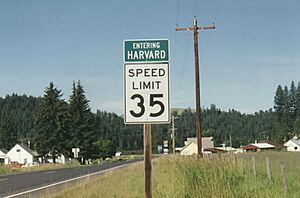Harvard, Idaho facts for kids
Quick facts for kids
Harvard, Idaho
|
|
|---|---|

Harvard in 1997
|
|
| Country | United States |
| State | Idaho |
| County | Latah |
| Elevation | 2,575 ft (785 m) |
| Time zone | UTC-8 (Pacific (PST)) |
| • Summer (DST) | UTC-7 (PDT) |
| ZIP code |
83834
|
| Area code(s) | 208, 986 |
| GNIS feature ID | 396618 |
Harvard is a small, quiet place in the northwest United States. It is not a big city, but an unincorporated community in Idaho. This means it is a settlement without its own local government.
Harvard is located in Latah County, on a beautiful area called the Palouse. It sits right by the Palouse River.
Contents
About Harvard, Idaho
Harvard is about 8 miles east of a town called Potlatch. You can find it along State Highway 6. Even though it is a small community, Harvard has its own post office with the ZIP code 83834. The area is quite high up, about 2,575 feet above sea level.
Close by, you will find Camp Grizzly, which is a summer camp for Boy Scouts. It is about 3 miles northeast of Harvard, nestled at the bottom of the Hoodoo Mountains.
History of Harvard
How Harvard Got Started
Harvard was founded in 1906. This happened when a railway, called the Washington, Idaho and Montana Railway, built tracks to this spot. The community has had its post office open since 1906.
The Name Harvard
The railway company first planned to call the community "Canfield." This name was after a local landowner named Homer Canfield. However, Mr. Canfield did not want the honor. He suggested the name "Harvard" instead.
He thought "Harvard" would be a nice match for a nearby community called Princeton. Princeton, located about 5 miles west, was named after Princeton, Minnesota.
Other College Names Nearby
You might notice other places in the area with names like famous colleges. These include Cornell, Purdue, Stanford, Vassar, Wellesley, and Yale. Some of these names were chosen on purpose, while others were just a coincidence.
Harvard's Population Over Time
When Harvard was first established, its population was estimated to be around 200 people in 1909. By 1960, the population had become smaller, with about 50 people living there.



